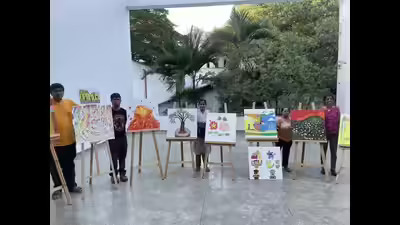Neurodiverse art exhibition Bengaluru begins with a wave of creativity and empowerment as the city’s leading cultural institution opens its doors to talent often overlooked. The neurodiverse art exhibition Bengaluru hosted at National Gallery of Modern Art, Bengaluru (NGMA Bengaluru) features the works of more than 50 individuals with mental-health, intellectual, or neurodevelopmental differences.
A platform for neuro-divergent voices
The exhibition emerges from a collaboration between NGMA Bengaluru and National Institute of Mental Health and Neuro Sciences (NIMHANS), bringing together art and inclusion in a powerful way. According to Aarti Jagannathan, Additional Professor of Psychiatric Social Work at NIMHANS, the workshops preceding the exhibition provided “a platform for individuals with mental illnesses and intellectual disabilities to create art.” Over 100 pieces (105 to be exact) were produced during the preparation phase; around 20 have already been sold, with proceeds returning to the exhibiting artists, helping foster financial independence and self-esteem.
Stories behind the canvases
Among the artists taking part was 27-year-old Jijo Das, who has Down syndrome and exhibited six of his paintings. Jijo’s aspiration is bold: he wants to become a concept artist at Disney Pixar. Another highlight was 17-year-old Shreyas Rajagopal, a student with ADHD and autism, who credited the NIMHANS workshops for helping him hone his skills and connect with fellow artists: “The painting workshops at NIMHANS helped me a lot … I got to meet new people and network at the exhibition.” These individual narratives show the dual power of art as self-expression and as a bridge to community.
Why it matters for culture and society
The significance of the neurodiverse art exhibition Bengaluru is manifold. On one level, it challenges societal norms that often categorise people with disabilities purely through deficit-based lenses. Here, neurodiversity is celebrated as a form of difference that carries creative strength. On another level, the event links art to social inclusion: by offering artists direct access to exhibition spaces, gallery networks, and market opportunities (including sales), the initiative supports empowerment beyond symbolic visibility.
For the cultural sector—galleries, museums, curators—this kind of programming signals a shift from “art for audiences” to “art by diverse creators”. It suggests a more inclusive conception of who counts as an artist, what themes are valid, and how art institutions can adopt broader mandates. For policy and public-education contexts, it demonstrates how art galleries can function as social inclusion platforms, not just display venues.
What visitors can expect
Visitors to the exhibition will see a wide range of styles and themes. The 105 works include acrylic and oil paintings, mandalas, portraits and karakal (ink) works—many drawing on personal experiences, sensory perceptions and dreams. According to the report, the artists were encouraged to “express themselves freely … without the fear of being judged”. If you’re planning a visit: take time to engage with the artist statements (where available), consider the materiality and texture of the works (some non-traditional mediums are used), and reflect on how the themes map onto neurodiversity—sensory experience, rhythm, repetition, layering, pattern. Also consider purchasing a work — the proceeds support the artists directly.







